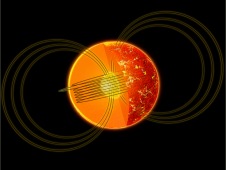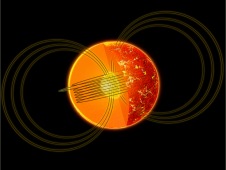
Neutron star SGR 0418+5729 shows off
Astronomy News – The human “Journey to the Beginning of Space and Time’ discovered another neutron star on June 5, 2009, that’s currently keeping astronomers and space scientists busy looking into the unusual properties of this newest member of the pulsar zoo. Astronomers using NASA’s Chandra, Swift and Rossi X-ray observatories, the Fermi Gamma-ray Space Telescope and ESA’s XMM-Newton telescope have been taking a look at this slowly rotating neutron star with an ordinary surface magnetic field as it gives off x-rays and gamma rays. Astronomers think the facts they have collected during their study of neutron star SGR 0418+5729 could indicate the presence of an internal magnetic field much more powerful than the surface magnetic field of this pulsar. This has definite implications in relation to the evolution of the most powerful magnets we have observed during the human “Journey to the Beginning of Space and Time” and astronomers are now delving into the mysteries they see within this neutron star to determine the facts.
Another strange neutron star
Astronomers looking at neutron star SGR 0418+5729 think this pulsar is one of a strange breed of neutron stars they refer too as magnetars, which normally have strong to extreme magnetic fields 20 to 100 times above the average for galactic radio pulsars they have viewed in the universe. What really has astronomers viewing SGR 0418+5729 scratching their heads is the fact that over a 490 day period of observing this pulsar astronomers saw no detectable decrease in this neutron stars rotational rate.
Astronomers think that the lack of rotational slowing of this neutron star could mean that the radiation of low-frequency waves is pretty weak, which leads them to believe the surface magnetic field of this pulsar must be quite a bit less powerful than normal. This conclusion gives astronomers another puzzle to solve, since with this thought astronomers are wondering where the energy for this neutron stars power bursts and x-ray emissions come from.
Does the power and energy creating this neutron stars power bursts and x-ray emissions originate in the twisting and amplifying of this pulsars internal magnetic field in the chaotic interior of this neutron star?
Present theories on this indicate that astronomers believe that if the internal magnetic field becomes ten or more times stronger than the surface magnetic field, the twisting or decay of the magnetic field could lead to the production of steady and bursting x-rays through the heating of the pulsar’s crust or the acceleration of particles in the magnetic field.
The question astronomers want to answer now is how large can the imbalance between the surface and interior magnetic fields be? If further observations indicate that the surface magnetic field limit is pushed too low, then astronomers will have to dig a little deeper into SGR 0418+5729 to find out why this neutron star is rotating slower.
Check out my latest astronomy website at http://astronomytonight.yolasite.com/.
Learn why astronomy binoculars are a popular choice with amateur astronomers
Read about the Anasazi Indians
Read about astronomers viewing a supernova they think might have given birth to a black hole

